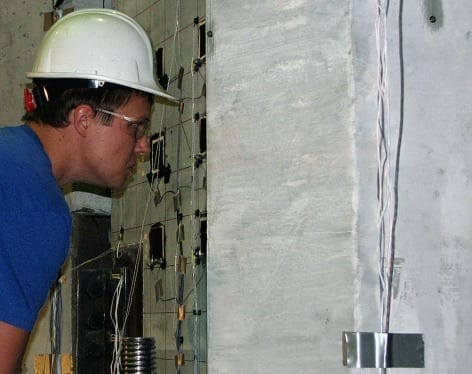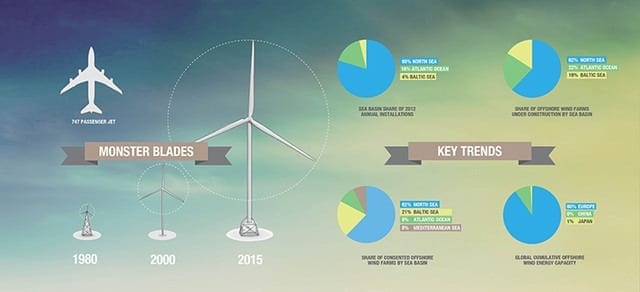
Could assembled concrete towers be a viable alternative to the steel towers now used for wind turbines?
Grant Schmitz, eyes inches from a 6.5-by-12-foot panel of ultra-high performance concrete, studied the smooth surface for tiny cracks. He and other research engineers carefully marked every one with black markers.
Schmitz, an Iowa State graduate student of civil, construction and environmental engineering, and Sri Sritharan, Iowa State’s Wilson Engineering Professor and leader of the ’s College of Engineering‘s Wind Energy Initiative, were trying to answer some basic questions about using concrete panels and columns to build wind turbine towers using prefabricated, easily transportable components.
Could assembled concrete towers be a viable alternative to the steel towers now used for wind turbines? Could concrete towers be a practical way to raise turbine towers from today’s 80 meters to the steadier winds at 100 meters and taller? Which of three ways to connect the columns and panels works best for wind turbine towers?
“We have definitely reached the limits of steel towers,” Sritharan said. “Increasing the steel tower by 20 meters will require significant cost increases and thus the wind energy industry is starting to say, ‘Why don’t we go to concrete?’”
And so, Sritharan and Schmitz watched as Doug Wood, engineering specialist and manager of Iowa State’s Structural Engineering Research Laboratory, typed in the commands for the lab’s hydraulic equipment to push or pull with bigger loads on a full-size test segment of a 100-meter concrete wind turbine tower. With each increase, the segment creaked and thumped.
The goal was to test three column-and-panel segments for the expected loads at the top of a turbine tower. The engineers wanted to see if the segments could handle 150,000 pounds of load, 20 percent over the extreme load at that height.
Sritharan and Schmitz designed the concrete towers to be built in hexagon-shaped segments, with six panels connected to six columns. They tested three methods to connect the panels and columns: bolted connections; horizontal, prestressed connections with cables running through the tower pieces; and a grout connection using ultra-high performance concrete poured into the joints between panels and columns. In addition, the concrete columns were attached to a foundation using prestressing methods.
All three versions of the test segments withstood 150,000 pounds of lateral load. The researchers also tested the segment with the grout connections under 170,000 pounds of load, 36 percent beyond extreme load. In each test, the segments performed well with no sign of distress at the operational load of 100,000 pounds. Some distress to the test segments was visible at the extreme load and beyond.
“Panel cracking was expected at very high loads and will be closed upon removal of the load,” Sritharan said. “This can also be avoided if this is requested by the industry.”
After all the testing, Schmitz said, “I definitely think we’re getting close to being able to use this technology in the industry.”
The concrete tower design offers several advantages over today’s steel towers:
The Latest Bing News on:
Wind turbine
- Brooklyn Gets a Wind Energy Makeover As Old Waterfront to Become Wind Hubon April 27, 2024 at 2:32 am
A giant construction company called Skanska has been chosen to transform a Brooklyn waterfront area into a major center for offshore wind power. An old shipping terminal in South Brooklyn will be ...
- GoFundMe launched for family of victim in fatal wind turbine accidenton April 27, 2024 at 12:43 am
The man who died after falling inside a wind turbine in Windthorst left a family behind, and a GoFundMe has been started to support them in their grief.
- Exclusive: Inside look at new wind turbine factory in Belenon April 26, 2024 at 10:17 pm
KOB 4 got an exclusive look inside a new wind turbine factory in Belen Friday. “And this company is a great example, we’re now poised to be the leader in the wind industry but a few years ago, they ...
- Wind Repowering: Putting Old Wind Turbines Back Into Serviceon April 26, 2024 at 3:53 pm
Wind repowering means revamping old turbines with more efficient components, or putting in new, state-of-the-art turbines on the site where outdated ones once stood.
- Will climate change suck the air out of Illinois' wind power industry?on April 26, 2024 at 11:43 am
Wind and solar are supposed to replace coal plants that are closing, but that didn’t happen in 2023. Another fossil fuel, natural gas, filled the void.
- Offshore Wind Farms Face Power Challengeson April 26, 2024 at 7:53 am
Using computer simulations and observational data of the atmosphere, the team calculated that the wake effect reduces total power generation by 34 percent to 38 percent at a proposed wind farm off the ...
- Will There Be Less Wind to Fuel Wind Energy?on April 26, 2024 at 3:29 am
Illinois policy says wind and solar are supposed to replace coal plants that are closing, but that didn’t happen in 2023. Another fossil fuel, natural gas, filled the void instead.
- A Lofty Future for Wind Energy, but State Goals Are No Breezeon April 25, 2024 at 2:25 pm
Business matters aside, the future is generally bright for offshore wind, leaders said at the 2024 International Partnering Forum for industry. Increasing state energy targets, however, present a ...
- Worker dies in fall from wind turbine near Windthorston April 25, 2024 at 12:57 pm
A man died after he fell from a wind turbine near Windthorst on Wednesday. He was identified Thursday as Marco Anthony Portillo, Jr., 31, of Weslaco. Archer County Sheriff Jack Curd said his office ...
- Gusts of activity underway by friends and foes of offshore wind energy projectson April 25, 2024 at 9:30 am
Supporters of offshore wind energy projects in New Jersey and New York are trading blows with opponents in some shore towns who say vacationers and local residents don't want to see turbines filling t ...
The Latest Google Headlines on:
Wind turbine
[google_news title=”” keyword=”wind turbine” num_posts=”10″ blurb_length=”0″ show_thumb=”left”]
The Latest Bing News on:
Wind power
- Exclusive: Inside look at new wind turbine factory in Belenon April 26, 2024 at 10:17 pm
KOB 4 got an exclusive look inside a new wind turbine factory in Belen Friday. “And this company is a great example, we’re now poised to be the leader in the wind industry but a few years ago, they ...
- Wind Repowering: Putting Old Wind Turbines Back Into Serviceon April 26, 2024 at 3:53 pm
Wind repowering means revamping old turbines with more efficient components, or putting in new, state-of-the-art turbines on the site where outdated ones once stood.
- Will climate change suck the air out of Illinois' wind power industry?on April 26, 2024 at 11:43 am
Wind and solar are supposed to replace coal plants that are closing, but that didn’t happen in 2023. Another fossil fuel, natural gas, filled the void.
- Wind turbines, discovery at archaeological site, housing market on decline | Top WAVY stories this weekon April 26, 2024 at 9:41 am
Wind turbines in Virginia Beach, major discovery at archaeological site in Colonial Williamsburg, and the housing market on decline. Top WAVY stories the week of April 22.
- Offshore Wind Farms Face Power Challengeson April 26, 2024 at 7:53 am
Using computer simulations and observational data of the atmosphere, the team calculated that the wake effect reduces total power generation by 34 percent to 38 percent at a proposed wind farm off the ...
- Worker dies in fall from wind turbine near Windthorston April 25, 2024 at 12:57 pm
A man died after he fell from a wind turbine near Windthorst on Wednesday. He was identified Thursday as Marco Anthony Portillo, Jr., 31, of Weslaco. Archer County Sheriff Jack Curd said his office ...
- Man killed from fall inside wind turbine identifiedon April 25, 2024 at 12:09 pm
ARCHER COUNTY ( KFDX/KJTL) — The man who died after falling inside of a wind turbine has been identified. Archer County Sheriff Jack Curd identified the man as 31-year-old Marco Anthony Portillo Jr.
- GE Vernova could not agree turbines switch on NY wind projects, CEO sayson April 25, 2024 at 5:02 am
Power services company GE Vernova could not reach an agreement to supply smaller turbines for three New York offshore wind developments before the contracts were canceled, CEO Scott Strazik told ...
- Researchers propose a new method for wind turbine blade recyclingon April 23, 2024 at 10:39 am
While wind energy is becoming one of the fastest-growing energy sources in the world, wind turbine blade waste emerges as a critical issue. Addressing this urgent environmental concern, Lithuanian ...
- Some say they felt ‘misled’ after it was revealed Dominion’s wind turbines could be seen from Virginia Beachon April 22, 2024 at 7:20 pm
For nearly four years now, two wind turbines standing more than 600-foot-tall have generated electricity 27 miles off the Virginia Beach coast. Aside from promotion mainly from their owners, utility ...
The Latest Google Headlines on:
Wind power
[google_news title=”” keyword=”wind power” num_posts=”10″ blurb_length=”0″ show_thumb=”left”]










